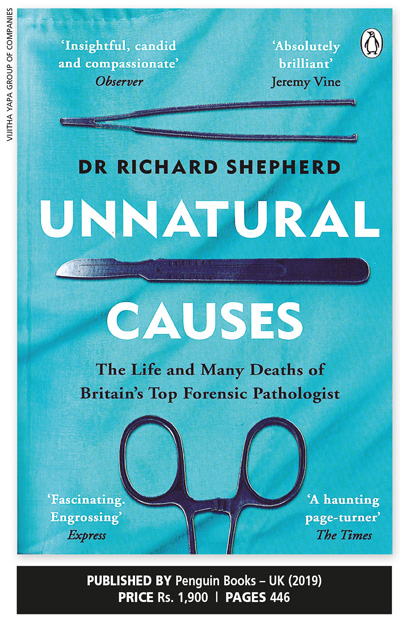BOOKRACK
By Vijitha Yapa
The dastardly Easter Sunday bombings – and resultant spate of deaths, injuries and general disruption to life in Sri Lanka – were uppermost in my mind as I read this fascinating book by Britain’s leading forensic pathologist Dr. Richard Shepherd.
During the course of his long career, he performed over 23,000 autopsies including that of Princess Diana who died under tragic circumstances.
What’s significant about this tome is that it isn’t merely a compilation of pathology case studies but also an honest review of the trials and tribulations that the author faced in his personal life as well. It would appear that his job affected his family life in many ways. For instance, the demand for immediate attention to perform autopsies placed a severe strain on Shepherd’s relationship with his wife and children.
His wife, who was a nurse, wanted to become a doctor and immersed herself in hours of study. This too put pressure on him as he was expected to finance the domestic expenses and help with taking care of the children as well.
On one occasion when he was rushing off to an inquest, even though he’d promised to spend time with the family, his wife remarked that the dead seemed to be more important to him than the living. Though that comment hurt him deeply at the time, Shepherd was a loyal civil servant and believed that when duty called, he must answer.
His experiments with stabbing, which included sinking a knife into the Sunday roast, meant that their children stopped eating the food he prepared. The good doctor had bought knives of all shapes and sharpness to test his theories; and he says that if a search was conducted by the police, he would have been arrested for carrying so many offensive weapons!
The pathologist also provides nuggets of information such as the difference between death as a result of a gunshot (where the killer can be far away from the victim) and stab wounds (where the perpetrator and victim need to be in very close proximity to each other).
Each autopsy reveals his attitude, which helped solve many cases – like that of a pretty girl who strangled her boyfriend with a tie. Was it murder or manslaughter?
He outlines the details and then provides a careful account of the autopsy findings, which reveal she had in fact murdered him. But the jury was not convinced and the frustration he felt is obvious as the killer was set free.
The author believes that a pathologist should never admit he was wrong because in the British justice system, there’s no room for probability. In one instance, while the police were trying to find clues about a killer, he discovered that the wounds on the victim were self-inflicted and called it a suicide.
Shepherd also dealt with a number of cases where children had been killed by their mothers. He says that it’s quite easy to kill a baby since the infant’s bones aren’t developed. The police have to then decide whether it’s infanticide or manslaughter.
And there’s the interesting case of a girl who pretended she wasn’t pregnant while working in a hotel. After the baby was born, she had taken the infant to a nearby lake and drowned the newborn. Stories like these make the book a page-turner.
In the case of unwanted pregnancies and the killing of children, paediatrician Sir Roy Meadow noted during the trial of a mother who stood accused of killing two of her children that one sudden infant death in a family is a tragedy, two is suspicious and three is murder unless proven otherwise.
He claimed that the odds of two children in the same family dying of natural causes were extremely high…one in 73 million, to be precise. The accused mother, Sally Clark, was found guilty and sentenced to life imprisonment.
One of the highlights of Shepherd’s career was the police inquiry into the death of Princess Diana. The inquest was held in 2004 in a bid to stem the inevitable tide of conspiracy theories and the author was asked to review the evidence. He describes how when a car travelling at 60 mph hits a concrete pillar, the bodies in the car continue to move.
Dodi Fayed, who wasn’t wearing a seat belt, crashed into the driver at 60 mph – and both were killed on the spot. Diana had a tear in a vein of one lung, about which Shepherd notes: “Diana’s was a very small injury – but in the wrong place.”
This could have been a dull book containing details of cases and information about the career of a pathologist. But Shepherd has made it an interesting read by balancing experiences in his professional life with the trials and tribulations he faced with his family… showing both sides of the coin as it were.




